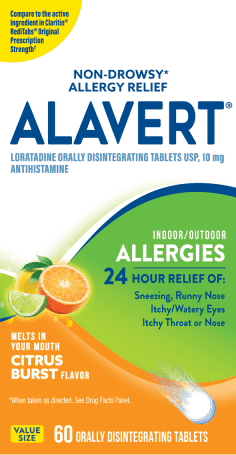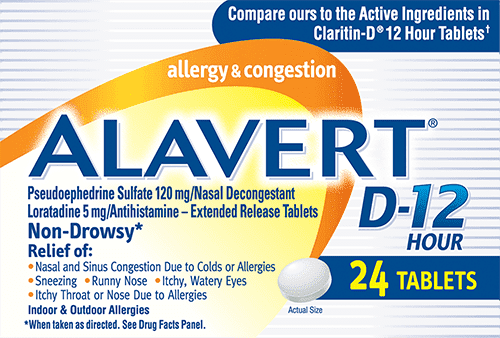Use Alavert Allergy citrus burst or mint by simply taking one tablet and letting it dissolve (or melt) in your mouth. It can be taken with or without water. One quick-dissolving tablet provides 24-hour, non-drowsy relief of your worst indoor and outdoor allergy symptoms, including: runny nose, sneezing, itching and watery eyes, and itching of the nose and throat. Do not cut or break Alavert in half.
Frequently asked questions
Questions about Alavert? Here are answers to some of our most frequently asked queries.
About Alavert Allergy
-
-
You can find Alavert Allergy right on the shelves of your local Food, Drug, or Mass retailer.
-
Alavert Allergy is available for adults and children 6 years and older. It’s one tablet that provides allergy relief for a full 24 hours.
-
All Alavert products contain the same active ingredient, loratadine, which is an antihistamine drug. Alavert D-12 contains two active ingredients: loratadine (an antihistamine) and pseudoephedrine sulfate (a nasal decongestant).
-
See label on carton for instructions on removing the Alavert Allergy tablet from its packaging.
About Alavert D-12 Allergy & Congestion
-
Alavert D-12 provides the relief that classic Alavert Allergy does, plus it has a powerful decongestant to help clear your worst nasal congestion and sinus pressure for up to 12 hours. Do not divide, crush, chew, or dissolve Alavert D-12.
-
You can find Alavert D-12 behind the pharmacy counter—without a prescription—at any one of our retailers. Visit our retailer page.
-
Alavert D-12 is available for adults and children 12 years and older. It’s one tablet that provides allergy, nasal congestion, and sinus pressure relief for up to 12 hours.
About Allergies
-
Over 50 million Americans suffer from allergies each year. And the number seems to be growing. But many people don't even know they have allergies or know what allergies actually are. Here's some basic allergy information to help you be more prepared.
-
Allergies occur when your body’s immune system overreacts to normally harmless substances in the environment such as pollen, molds, animal dander, latex, certain foods, and insect stings. Substances that cause these reactions are called allergens. Those who are prone to allergies view these allergens as “harmful invaders,” and their immune systems (the body’s defense system) are prompted to respond with an allergic reaction.
If you are prone to allergies, the first time you’re exposed to a specific allergen (such as pollen), your body’s immune system will respond by producing antibodies to the allergen. The function of these antibodies is to identify the allergens and help remove them from your system. As a result, a chemical called histamine is released, thus triggering symptoms of allergies.
-
Some people who suffer from allergies don't know they have them because many of the symptoms (such as sneezing or a runny nose) are similar to those of the common cold.
Typical allergy symptoms are:
- runny nose
- sneezing
- itchy, watery eyes
- itching of the nose or throat
- nasal congestion or sinus congestion
- hives, rash, or itchy red spots on the skin
Itchy and watery eyes and sneezing are often telltale signs that the symptoms are due to an allergy. A fever can occur with a severe cold, especially in children, but is not an allergy symptom. A sore throat can occur with allergies but is more common with a cold.
-
Use Alavert Allergy: The allergy relief medicine that costs a lot less than Claritin® allergy medicines. Alavert Allergy quick orally dissolving tablets can help with your allergy symptoms. Alavert includes an antihistamine drug and relieves sneezing, runny nose, itchy, watery eyes, and itching of the nose and throat.
Use Alavert D-12 Allergy & Congestion: Alavert D-12 extended relief tablets include an antihistamine drug in addition to a nasal decongestant. It provides 12 hours of multi-symptom relief of nasal congestion and sinus pressure, in addition to your other allergy symptoms of sneezing, runny nose, itchy, watery eyes, and itching of the nose and throat.
Alavert is not indicated to relieve hives, rash, or any other type of skin irritation.
Here are some tips for fighting allergies at home:
Pollen, mold, dust, and other allergens can be found everywhere and can cause symptoms in allergy sufferers. There may be more allergens on surfaces than in the air, and they can enter the air easily when you disturb them by dusting or sitting down. Here are some steps you can take around your house to make allergy season more bearable:
Mask the Situation
Wear a mask that completely covers your nose and mouth when you mow the grass, rake leaves, and/or do garden work.Take Leave
Are your kids allergic to mold? Keep them from jumping in fallen and decomposing autumn leaves.Break the Mold
Keep mold from building up indoors; clean out humidifiers and AC filters so mold spores don’t accumulate.Rug Rats
Dust mites love a good carpet, so try not to roll around on the rug with kids and pets. Also, curtains and blinds are preferred hiding places for dust and mold. Dust and vacuum regularly. -
Most allergies are inherited, which means the tendency to be allergic is passed on to children by their parents. So, if your mother or father has allergies, there’s a chance you’ll have or develop allergies too. However, you may not be allergic to the same allergens as they are. The environment you live in, air pollution, and pollen in the air can all have major effects, but they may differ between individuals that are prone to allergic reactions.



